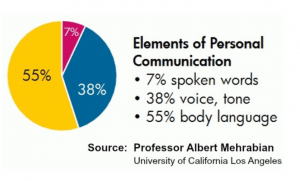Recently I was introduced to the visual below and used it to engage in discussions at my school to strengthen our role of Process Observer at Professional Learning Communities (PLCs):

In the past our Process Observers and teams focused on asset-based language at PLCs, and we are now shifting to also focus on all elements of communication, especially in connection to each team’s Working Agreements and in our classroom climate. In this post, I want to connect the multiple ways of communication with the stories we tell/the lenses through which we interpret situations. I will connect this to the work of Jennifer Abrams and the idea of Cognitive Appraisal.
In Mind Your Body Language, Neetu Ganapathy writes:
“When we speak, what we say is not as important as how we say it. We may choose the most powerful words to inspire our audience, while our body language may contradict everything we are saying. This implies that while we need to choose our words with care, we need to take greater care about our body language when we speak.”
Ganapathy explains that there are a number of components of body language, including: Facial expressions, Eye contact, Gestures, Posture and Movement.
This connects to
“I’ve come to a frightening conclusion that I am the decisive element in the classroom. It’s my personal approach that creates the climate. It’s my daily mood that makes the weather. As a teacher, I possess a tremendous power to make a child’s life miserable or joyous. I can be a tool of torture or an instrument of inspiration. I can humiliate or heal. In all situations, it is my response that decides whether a crisis will be escalated or de-escalated and a child humanized or dehumanized.”
A systems approach shows us that not only do we influence the climate in our classrooms, but we also influence the whole system. All actions ripple in and out within a system. For this reason, focusing on Body Language and Tone are natural next steps after a focus on Asset-based Language.
I attended a session with Jennifer Abrams at the Wisconsin State Reading Association a few weeks ago. Abrams spoke how the ways in which adults talk with each other needs to be on the “front burner” of our work. She said,” Our conversations invent us.” It made me think also about Aguilar’s “Every conversation is a conversation about equity.” The ways we talk with each other can build trust, regard, competence, efficacy, and trust; which all lead to an increase in effectiveness and student belonging which is needed to increase achievement. We can have transformational conversations rather than transactional. Now more than ever, transformational conversations are needed to dismantle systems of oppression and rethink the ways we do education. (For more on Belonging, see past posts. For more on the impact of Efficacy, see Hattie.)
We must have high expectations for communication, in our PLCs and in our classrooms.
In order to examine and improve the ways we talk to each other, we need to have a learner mindset. Every teacher, every human is on a journey of learning. We need to do self work to transform situations, and to be fully present to learn from and with our colleagues and students. Abrams asks, “Would you want to fly with a pilot who has stopped learning? Have surgery performed by a surgeon who has stopped learning?”
In her latest book, Stretching Your Learning Edges: Growing (Up) At Work, Abrams provides self-assessments and activities to support each of the facets of personal and professional growth. I look forward to examining these more closely and integrating them into future steps in my school system.
Facet #1 – Know your identity
Facet #2 – Suspend certainty
Facet #3 – Take responsibility
Facet #4 – Engage in reciprocity
Facet #5 – Build resiliency
Three ideas from Abrams connect to the next section of my post: bias impacts your teaching, we need to work with others in humane and growth-producing ways, and as teammates and teachers we need to manage our emotions rather than producing “Emotion Pollution.”
In today’s meditation on Healthy Minds App, I was reminded that the most effective strategy to change my emotional responses to a situation: change my interpretation of the situation. Because our brains cannot take in all the information in a given moment, they have to be selective and filter information through the lenses of our experiences. As a result, “there’s always a judgment or story that goes along with how we judge or perceive a situation. Different interpretations of the same situation might provoke different emotions.
We can’t always control the situations we are in but we can control how we react to the situation and that makes all of the difference.” This is called Cognitive Reappraisal or Flipping the Script and is a useful tool for compassion. “Flipping the Script also flips a switch in the brain. When we change our interpretation of a situation, the emotional centers in our brain are less active which strengthens self-regulation.”
We can shift the whole tone of a situation.
As Victor E. Frankl stated,
“Between stimulus and response there is a space. In that space is our power to choose our response. In our response lies our growth and our freedom.”
I believe that as we become more reflective on ourselves, the ways we show up, and the impact we have on others, we can truly begin to transform our systems to best serve our Students, our Dreamers.
Resources:
Healthy Minds App
Stretching Your Learning Edges: Growing (Up) At Work, Jennifer Abrams
“Our Conversations Invent Us,” Jennifer Abrams, Wisconsin State Reading Association Presentation, 2/2022
Mind Your Body Language, Neetu Ganapathy